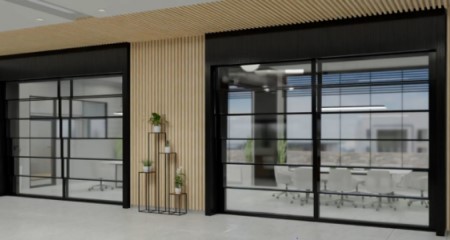Exploring the WELL Building Standard and How Operable Walls Can Contribute to Creating a Healthy Work Environment
As we become more conscious of the impact of our environment on our health and well-being, more focus is being placed on the work environment. Building owners and employers are placing increased emphasis on the workplace to ensure that the environment promotes physical and mental health. That’s where the WELL Building Standard comes in.
Let’s explore the principles behind the WELL Building Standard, how it can help create a healthier work environment and where operable walls can play a part.
What is the WELL Building Standard?
At its core, the WELL Building Standard is focused on improving the quality of the indoor environment. This includes everything from air quality and water quality to lighting and acoustics. It also includes features that promote physical activity, healthy eating, and mental well-being. By addressing these factors, the Standard aims to create an environment that supports the health and well-being of building occupants.
The WELL Building Standard is a performance-based system for measuring, certifying, and monitoring features of the built environment that impact human health and well-being. The standard is designed to be flexible and adaptable to different building types and locations, and it can be applied to new construction projects or existing buildings that are being renovated.
Benefits of implementing the WELL Building Standard in the workplace
There are many benefits to implementing the WELL Building Standard in the workplace. For one, a healthier work environment can help reduce absenteeism and improve employee productivity. Studies have shown that workers in healthy buildings are more productive, take fewer sick days, and are less likely to suffer from stress-related illnesses.
Implementing the WELL Building Standard can also help to attract and retain top talent. In a survey conducted by the IWBI, 87% of respondents said that they would prefer to work for a company that prioritizes employee health and well-being, and 70% said that they would be more likely to stay with a company that invests in their health and wellness.
Key features of the WELL Building Standard
The WELL Building Standard is comprised of ten categories, or “concepts,” that cover different aspects of building design and construction. They are:
- Air quality
- Water quality
- Nourishment
- Light
- Movement
- Thermal Comfort
- Sound
- Materials
- Mind
- Community
WELL Building Certification is a process that involves a review of a building’s features as well as performance verification. To achieve certification, buildings must earn a minimum number of points across the standards ten concepts. There are four levels of certification available: Silver, Gold, Platinum, and Core & Shell.
Do WELL by incorporating operable walls
Incorporating operable walls in your building design can contribute points toward WELL Building Certification in the light, sound, and materials concepts.
To promote natural light in the workplace, the WELL Building Standard requires that buildings have adequate windows and that their design allows for natural light to reach all areas of the building. Additionally, the standard requires that lighting systems be designed to support the body’s natural circadian rhythms.
Natural daylight is irreplaceable and achievable with Skyfold’s Mirage® and the new Skyfold Prisma™. Integrating daylight with Skyfold’s Mirage or Prisma and electric light with Skyfold’s Classic™ and Zenith® to create lighting strategies focused on human health, along with traditional requirements for visual acuity and comfort, lead to healthier and more productive environments.
The WELL Building Standard requires that buildings be designed to reduce noise levels and provide acoustic comfort. Skyfold is the acoustic leader in vertically folding retractable walls. When deployed, Skyfold becomes a decoupled double, rigid wall and acoustic barrier with acoustic ratings of up to STC 60 (Rw 59 dB) and NRC/SAC of up to 0.65.
Materials matter. The standard requires that buildings use non-toxic and sustainable materials whenever possible. Skyfold is committed to promoting better and more sustainable buildings with the highest indoor environmental quality. Our commitment extends not only to the products we make, but also to our operations and manufacturing techniques used in our facilities.
The Skyfold Guide to WELLness provides additional details on the Skyfold products that are applicable to the sound, light and materials concepts. The Modernfold Chicago Skyfold experts are on hand to collaborate with you to help create a healthy work environment.



